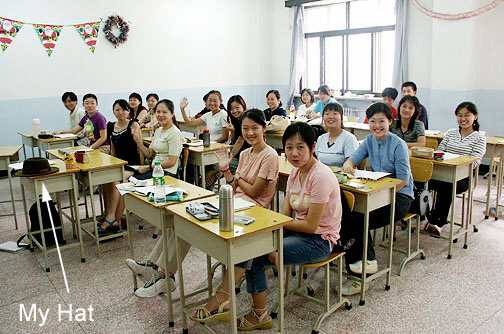Talk about no time to prepare! On Sunday I toured the two schools I would be teaching at, and had a look at the 1-room dorm in which I’ll be staying. I was to start the next morning! My schedule concerned me a little, though. Five days a week (mostly mornings) I’d be teaching three 2-hour classes at the Beijing Information Technology college. No problem there. In addition, I was to teach at the Beijing Chemical Engineering School (which is really a high-school level vocational school) three days per week, and I would have four 1-hour classes in the afternoons. “Are the kids in the four classes at the same level? Can I use the same lesson plan for all four classes?” “No different students. Same students all four hours!”
Did I hear that right? 4 hours straight with the same kids? Perhaps something got lost in the translation. If this were an American high school, we’d all kill each other at the end of the fourth hour. High school-age kids don’t have that kind of attention span (and frankly, neither do I)! None of that description passed my internal reality check mechanism. And yet, I had to proceed as if it were true, just in case. They gave me 2 textbooks and vague written instructions for the taxi driver to follow as I shuttled from school to school. (I have to leave enough time for the taxi drivers to get lost 3 times on the way there.) I received no textbooks at all for the more advanced students at the IT college.
Now we get to the fun part of what do you teach when you have no objectives and no materials. An even more relevant question is, what is the best way to teach a language to others? Anyone who’s ever taken a class can tell you that just because somebody knows a subject doesn’t mean they can teach it effectively. And with this job, there was no formal training – they all assumed that I was an expert!
What is the best way to teach? While I was interviewing at different schools each presented their own methodologies, and each claimed to have an outstanding track record (which I don’t doubt). One private school wanted me to teach second graders using the Carden method, a 100-year-old franchise teaching system which integrated several senses at once; the super-expensive Wall Street English school in the heart of the Beijing business district had a nice system where students would learn the basics using computer-aided instruction, and then convene with a teacher to immediately practice and reinforce what was learned. A nice system indeed.

Hey! Look at me! I’m in China!!

The front of Beijing Information Technology College.
The best method for learning language I have encountered so far is the Pimsleur system; I have been learning Mandarin using their audio tapes and it is surprisingly painless and effective if you spend only an hour a day (with a lot of practice on the side, of course!). The Pimsleur system is based upon learning research done by a language professor of the same name. He discovered that a new word or phrase only needs to be repeated about 10 times in increasing intervals (for example 15 seconds, 30 seconds, one minute, 3 minutes, 9 minutes, 20 minutes, etc.) in order to go from short-term memory to long-term memory. Other mechanisms, such as mental anticipation of the answer (along with instant confirmation), and how to avoid the mechanics of grammar and learn correct use the same way an infant does are all rolled into an audio course that is available for about 30 languages. Could I leverage these one-on-one learning principles and adapt them to a one-to-many environment?
My first class was at the IT college which is a 15-minute drive from where I was staying, unless you go at 7:30 AM during rush hour traffic, in which case it takes 40 minutes. I walked into my first class 10 minutes late.
“Good evening, class!” “Good morning, Teacher!” (Good! They know the difference.) On the board I wrote my name, and then across the top I wrote, in very large letters, “IT IS O.K. TO MAKE MISTAKES!” (I’m sure no Chinese teacher ever told them THAT before!) “You have to speak badly before you can speak well”, I explained. I wanted to understand where they were in terms of vocabulary, so I started asking some questions. “Raise your hand if you see the color White.” The entire room was painted white. Not a single hand went up. I went to individual students and introduced myself, and they responded with a “My name is”, and a “Nice to meet you”. (Students of English are often given English names so their white imperialist teachers can understand them – otherwise there is no hope!. These kids all had theirs pre-assigned, and some were unusual such as Summer, Apple, and Dolphin. I took extensive notes.)
“Tell me if you know these words”. On the board I wrote the words Aggressive, Timid, Lazy, Grieving, and the phrase “Ecstatic with Joy”. One person thought they knew Timid (and in fact she did) but ironically I couldn’t get a full sentence out of her. One thing I learned very quickly is all Chinese students tend to be very shy, and won’t normally speak up. Time to shake things up a little.
I pointed to the word Lazy, slowly walked to the back of the room, took off my shoes, sat down in an empty chair and put my feet up on the desk. I could tell by the reactions of shock and laughter that I had already broken at least 3 taboos regarding teacher behavior. I slowly said, in my best whiny voice, “I don’t want to go to school. I don’t want to work. I want to go back to sleep! I am being…” and I pointed to the board at the front of the room. “Lazy” said 3 students. “What?” “Lazy!!” came a louder response. Then I pointed to the word “Aggressive”, and went to another student and challenged him to a race across the classroom. 3..2..1..GO! and just as he started running I blocked him with my arm so I could finish first. Then I was a sore winner. Speaking very slowly and loudly, I said “Ha! I’m faster than you! I’m better than you! I won! HA! I am also better looking than you, and have more hair!”. (Note to some of you: I shaved my head last July. It’s a long story.) “I am being…” “Aggressive!” came the response. Again, a lot of laughs. Throughout the first hour I reinforced these new words with the same frequency as the Pimsleur system, behaving a little crazy each time to get the definition of the word across. The students opened up and by the hour’s end they could all use 15 new words in written sentences.

One of my classes. Notice my hat on the left, which proved to be an invaluable icebreaker.
After the first hour I figured out that their vocabulary was very good, and in fact they have all read very involved texts in English, but their speaking skills (which, combined with their shyness, make the perception twice as strong) needed polishing. I divided them up into groups of 4, and told them to interview the person to their right using only English, for you are going to introduce them to the class later on. They did a reasonable job, and my “mistakes are OK” rule removed a lot of pressure. My mission from here on is to build their vocabulary and get them to speak as much as possible.
The Chemical Engineering school was a different story. Although it was only a 20-minute drive from the palace of a high school I was staying at the previous week, it is decorated in Early American Peace Corps. Peeling paint from the walls, dark hallways, and squat toilets that would make my Mom scream. Finally, the old China!
The students were very sweet but also about 8 levels behind the textbooks I was given. Every question I asked was greeted with blank stares. I drew a vertical line on the chalkboard (yes, a squeaky cracked chalkboard) with the word HARD at the top and EASY at the bottom. Next to EASY I started to say and write names of “easy” languages – Spanish, Portuguese, Esperanto. (I got these rankings from a linguist friend of mine.) Near the top I started to list more difficult languages: German, Russian, Japanese, and finally at the top I put Chinese. English was right in the middle. I could see by their expressions that they understood. Okay, a starting point. How do I find out where these kids are?

One of the classrooms at the Chemical Engineering School.

The dreary hallway leading up to my room. Luckily, things got nicer once I got inside.
I took my hat (which I now wear constantly while outside — see the earlier paragraph that talks about me shaving my head), crushed it into a ball and threw it in the air. One random kid caught it. “Aha! A volunteer!” Nobody understood the words, but they all understood the meaning. A lot of laughs. I introduced myself, and she introduced herself back. Good. I threw the hat to someone else. I said slowly, “What is your favorite color?” “My favorite color is red.” was the reply after about 10 seconds. I did this for several minutes, me throwing the hat and then asking progressively harder questions so I could find the range of their knowledge. “What time is it?” “What are your hobbies?” “What is 200 minus 100?” “What is the opposite of hot?” “What kind of job do you want?” “How much money do you want to make?”
Then I had one student stand up and say something about herself. “I like playing computer games” was her statement. I threw the hat to someone else and said, “What did she just say?” After thinking about it, the answer came back, “She likes playing computer games”, with the noun and verb properly modified to refer to another person! (Hmmm…. I need to create more thinking problems like that!)
Eventually the kids got into throwing the hat to each other and then one kid would ask a question of another. The hat proved very popular for the next 4 hours; it became great social entertainment to see who could embarrass who by making them ‘volunteer’ next, regardless of the subject.
By the end of the 4th hour, using physical acting and a plethora of non-verbal communication techniques, I had built up in them a vocabulary of different job titles (plumber, electrician, mechanic, secretary, businessman/woman, etc., again using Pimselur intervals), and had the kids doing (very scripted) mock job interviews with each other. Everyone had a good time, and my concerns about 4 hours with high school students were allayed.
Score: Gary 1, China 0.
My New Place
Later that evening I moved into a dorm room at the Information Technology college. Let me state outright that I know better than to expect a college that specializes in computers to actually have internet access in classrooms or dorms. There’s only one location I’ve found so far; and it is in a teacher’s office. Dialup isn’t even possible, since the dorm phones cannot get an outside line. A moot point in my case, since my phone wasn’t working either. I knew exactly what needed to be done to fix it — There was no dial tone when you picked it up, but you could hear yourself blowing into the mouthpiece and you could hear the touch tones as you pushed the button. This told me that the phone, wire, and central switch were all healthy. All that needed to be done was find the central switch and reprogram it to make my extension “active”. I couldn’t communicate that with my extensive vocabulary of 23 words. The next day the phone was fixed — someone went to the nearby telephone pole and strung in a new line through my window (which I now cannot close fully). I hope it doesn’t get too cold this winter!
The dorm is actually quite nice once you get inside; in stark contrast to the decaying hallways you must traverse to get there. The 3’x5′ combination closet/toilet/shower/sink/water heater room provides a lot of things that a westerner can poke fun at (like the electrical connection within six inches of the shower head; see photo) but in fact this kind of insipid, cramped, ill-ventilated bathroom design permeates most of Western Europe as well as the east. It’s in the category of things (like politics, sugar, and Microsoft) that are ubiquitous and lacking yet nobody notices that there’s a problem. I am thankful that they gave me a western-style toilet, although by now I am accustomed to using the characteristic eastern “squat toilet” (see image on right, below).


Nice ceiling.

The top half of the closet bathroom and shower. Notice the proximity of water and electrical outlets.



Other Tidbits
I now understand where the phrase “All the tea in China” comes from. I knew they were famous for consuming it; I just couldn’t fathom how much! All students have glasses of hot water on their desks with a ton of tea leaves brewing at the bottom; after classes there are huge lines at the hot water dispenser for students to fill up their (quite large) thermoses for tea making later in the evening. Tea shops line the streets. (Chairman Mao is said to have his own special trees from which his tea was harvested.) Another thing I was impressed with was the concept of “home room” in the schools — they take the term quite literally! All of the kids stay in one classroom; and the teachers rotate in and out.
Anyone who thinks that China’s promise to crack down on software or entertainment piracy as a pre-condition to being admitted to the WTO was enforceable has another think coming. One cannot walk down the street (looking like a foreigner, or “big nose” in the local language) without being bombarded by entrepreneurs selling illegal DVDs of movies that released in America only a week earlier. All the expense and technical effort by the entertainment industry to add copy protection and “continent designations” to their published works has been completely circumvented by people who walk into movie theatres with a pocket digital movie camera and record the full length film, so they can be published in China days later. It is kind of amazing and comforting to know that I am being harassed with the latest and best Hollywood has to offer.
Until next time…
“Yours Truly, Gary Friedman”
September 3, 2003

School grounds are peppered with ancient wisdom etched into rocks.
